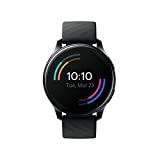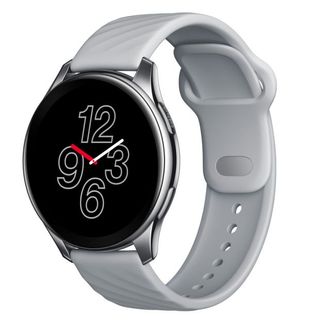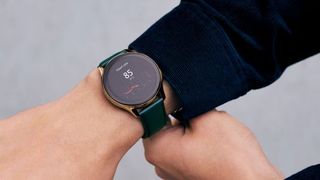Our Verdict
A beautiful watch with excellent battery life at a reasonable price, let down by basic functionality, GPS inaccuracy and app issues.
For
- Great looks
- Long battery life
- Reasonable price
Against
- Basic functionality
- GPS is wildly inaccurate
- Uncomfortable strap
- App won’t play nice with others
You can trust Coach
OnePlus has a history of building smartphones with top-end specs at prices the big boys can’t match. The company’s first smartwatch, however, is not such a success. It looks the part, is well priced and has an incredible battery life, but the functionality is basic, the app can’t send your run data to third-party apps like Strava, and even if it could, the GPS data is so flawed that you probably wouldn’t want it to.

£141.13
OnePlus Watch In-Depth
Design Of The OnePlus Watch

It’s hard not to be charmed by the OnePlus Watch’s appearance. It’s as good-looking as the best fitness smartwatches, with a large 1.39in (35mm) AMOLED touch display that really catches the eye.
When the screen comes to life with a flick of the wrist or press of one of the two side buttons, it’s a pleasure to look at. (An always-on display was added in a recent update, though it’s disabled by default.) Sharp text and icons stand out brilliantly against the black background.
Although beautiful to look at, it might sit less beautifully on smaller wrists because it’s only available in a 46mm size – smartwatches typically also offer 40mm and/or 44mm options.
I didn’t get on with the bundled fluoroelastomer strap either. This is one of those straps that needs to be tucked into itself before you can pop the stud through the hole to secure it, and I was never able to find the right fit. It either slipped around or was so tight that it left an imprint.

You can (and almost certainly would) buy a third-party 22mm watch strap to replace this, but it’s a real let-down that the strap is so poor when the rest of the hardware is so well designed.
Smart Features On The OnePlus Watch
OnePlus has gone its own way software-wise, running OnePlus Watch OS, rather than sticking with Google’s Wear OS. The latter has its problems (it’s bloated, it’s a battery hog and it can run slowly on lower-powered devices), but it is quite sophisticated with a mature app store.
OnePlus Watch OS is, at the time of writing, not terribly well thought out and feels quite basic. The main screen is a customisable watch face, then swiping left reveals three more: one that shows your heart rate, another that shows you your recent sleep and a final one with media controls.

More functionality is hidden away behind the two buttons. By default, the bottom one lets you select from a number of exercises, while the top one lets you look at your recent workouts, check the weather, set an alarm, use a torch, activate your phone camera remotely, check the compass or barometer, and check in on your blood oxygen levels and stress levels. You can even use your watch as a remote if you own one of the few OnePlus TVs out there.
Having all these in a single list both feels simultaneously overwhelming and revealing of how few essential functions are actually present – the company’s priorities seem strange. There’s no contactless payment included, but you can answer calls from a tiny speaker and mic in the watch, if you like.
Notifications are a mixed bag too. WhatsApp messages allow lots of characters, so you can read entire messages in one go, but Gmail emails are limited to subject lines, with no way of seeing the contents.
One final but, for many, crucial thing: the OnePlus Watch won’t work with iPhones, although that may change.
Fitness Tracking With The OnePlus Watch
The basics – steps and calories – are tracked as you go, and, as first seen on the Apple Watch, visualised via rings on the homescreen which fill as you move around. Tapping on the screen will give you exact figures. It will also automatically detect when you’ve been walking for a while and ask if you want to track it as a workout, which is nice.
At launch, the OnePlus Watch arrived with 13 workouts, but a June update bumped this number to well over 100. That sounds impressive, but do you need 13 different kinds of yoga? Different options for jazz, Latin, tango and tap dance? The ability to track dog walking, darts and flying a kite? It feels like the aim was just to hit triple figures.
Running With The OnePlus Watch
On paper the OnePlus Watch, with its built-in GPS and support for GLONASS, Galileo and Beidou (the Russian, EU and Chinese satellite systems, respectively), would be a boon for runners. In practice, I was very glad I had my Garmin Forerunner 245 on the other wrist.
Firstly, the OnePlus Watch took an age to locate a GPS signal. While my Forerunner 245 was ready to go within 20 seconds of stepping outside, the OnePlus Watch would sometimes take well over two minutes. Starting before it locked on was, as you might expect, a recipe for rubbish data, but the surprising thing is that it wasn’t much better even if I waited around for a locked GPS signal.
The OnePlus Watch was, without fail, more than a kilometre behind my reliably accurate Forerunner 245 watch over a 5km distance. Over five runs measuring between 5 and 5.02km on the Forerunner 245, OnePlus Health gave readings of 3.91km, 3.81km, 3.57km, 3.93km and 3.81km.
It’s a pity that the distance and therefore pace numbers are so far off, because the data is well laid out while you’re running and in the app afterwards. Other metrics include heart rate, heart rate zones, cadence and elevation.
Even if I’ve just been unlucky with the review unit (which is doubtful, given other reviewers have had similar experiences) there are other reasons not to trust your fitness tracking to this generation of OnePlus Watch.
For starters, while a recently added Marathon mode hints that coaching options may be on the way (if you select it, the watch offers to take a fitness reading to offer better advice in future), shorter runs don’t offer any of the training pointers that you can find on similar priced devices like the Garmin Forerunner 45. Secondly, the OnePlus Health app currently connects only to Google Fit, with no option to connect to anything else like Strava or MyFitnessPal.
It’s encouraging that OnePlus seems to be supporting the watch with regular updates, but I can’t shake the feeling that this would have benefited from a whole lot more time in development – especially when updates promising GPS fixes have so far not delivered any demonstrable improvement to the weak accuracy and slow lock-on times.
Sleep Tracking With The OnePlus Watch
The functionality here does little more than the bare minimum. It will track your time spent in both deep and light sleep, as well as moments it knows that you’re awake, and will tell you whether a stat is normal or insufficient. What it won’t tell you is how to improve these metrics in any meaningful way. For example, the app told me on a night where I managed 69% deep sleep that this was “insufficient” and I should aim for more than 80% of my sleep time being classified as “deep”. That’s great, but how? There’s no answer here.
It’s a bit harsh to pick on OnePlus for this given plenty of other wearable makers fall into this trap. But with the OnePlus Watch already feeling a touch underdone in other ways, the threadbare functionality here stands out all the more.
Battery Life On The OnePlus Watch
Battery life is one area where the OnePlus Watch gets an unambiguous thumbs up. OnePlus says it should last 14 days or up to 25 hours of GPS. Assuming you keep the always-on display off, and don’t turn on SpO2 sleep tracking, that seems pretty accurate to me, which somewhat vindicates OnePlus’s choice to use its own operating system rather than Google’s Wear OS.
When you need to charge it, the OnePlus Watch sits in its own charging cradle. OnePlus says it’ll get 50% of its battery back within 20 minutes – enough to get you through a week.
See related
Should You Buy Something Else?
Reviewing the OnePlus Watch has been a frustrating experience. The beautiful hardware, long battery life and reasonable price are let down by almost everything else. This is a product that feels like it needed more time in development – which is pretty damning when the company has been working on fitness trackers since at least 2014, when it almost launched one.
Perhaps a second generation will build on those strong suits and release something really special, and it’s encouraging to see OnePlus pushing out updates fairly regularly to make the best of a bad lot with its first wearable.
Superior alternatives include the Huawei Watch GT 2e, which offers a more polished experience with the same phenomenal battery life, and although it retails for around the same price, it's often under the £100 mark. Alternatively, if you’re not put off by the more utilitarian look of a running watch, then Garmin’s Forerunner 45 is worth considering at around £130.
Alan is a freelance tech journalist and mostly covers fitness trackers for Coach.
Alan was not what you would call a big fitness guy growing up, but has been radicalised by parkrun and taken up running in a big way. Although nowhere near podium at races, as a late starter he does at least know that he can still get faster. Alan has written for ShortList, Tom’s Guide, Trusted Reviews and Expert Reviews, among others.


